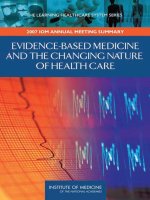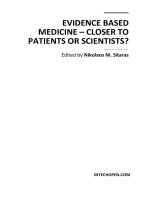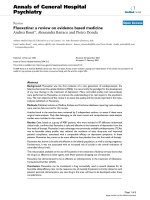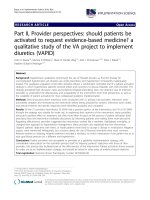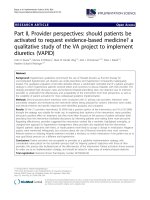Lecture Evidence based medicine: Effectiveness of therapy
Bạn đang xem bản rút gọn của tài liệu. Xem và tải ngay bản đầy đủ của tài liệu tại đây (267.9 KB, 30 trang )
EVIDENCE BASED
MEDICINE
Effectiveness of therapy
Ross Lawrenson
Critically appraising a therapy
paper
Critical Appraisal of a therapy
paper methodology
• When critically appraising a paper
ask yourself three questions:
– Are the results valid?
– What are the results?
– Will the results help me in caring for
my patients?
• Go to the therapy worksheet for the
complete list of questions
I. Are the results valid?
• In other words was this a well designed
study in a relevant population. The best
study design to answer a therapy question
is a randomised controlled trial.
• Go through the worksheet questions 1 6 to
help you decide whether you are likely to
believe the results of the paper you are
considering.
1. Did the study address a clearly
focused question?
• Can you define
– The population they studied
– The intervention
– The comparison group
– The outcomes
2. Was the assignment of patients
randomised?
Efficacy versus effectiveness
Efficacy versus effectiveness
• Efficacy does receiving treatment
work under ideal conditions?
Efficacy versus effectiveness
• Efficacy does receiving treatment
work under ideal conditions?
• Effectiveness does offering treatment
help under ordinary circumstances?
Observation versus
experimental studies.
Observation versus experimental
studies
• A study population of 2000 patients
with acute coronary heart disease of
whom half receive a certain
intervention and the other half do
not. Of the 2000 patients, 700 have
arrhythmia "X" and 1300 do not.
Observation versus experimental
studies
• A study population of 2000 patients with
acute coronaries of whom half receive a
certain intervention and the other half do
not. Of the 2000 patients, 700 have
arrhythmia "X" and 1300 do not.
• X(+) = Patients with arrhythmia "X"
have a mortality of 50%
• X() = Patients without arrhythmia have
a mortality of 10%.
Observational study
Intervention
No intervention
X()
800
X()
500
X(+)
200
Deaths 180
Relative risk = 0.6
X(+)
500
300
Randomised controlled trial
Intervention
No intervention
X()
650
X()
650
X(+)
350
Deaths 240
Relative risk = 1
X(+)
350
240
Absolute risk
• Incidence rate of the outcome in the
population (can be the treated or the
untreated population).
Relative risk
• Relative risk (RR) is the absolute risk
in the treated group divided by the
absolute risk in the untreated group (or
vice versa)
Randomised controlled trials
• Because the randomised trial removes selection
bias the result of the study should be believed
over the evidence from the observational study
i.e. the Relative risk is 1 (no difference in
treatment) not 0.6 (which suggested a benefit
from treatment.)
• An example of this would be the use of HRT
and the reduction in cardiovascular risk.
Observational studies have shown a 50%
reduction in CHD but the RCT showed no
benefit. (References)
3. Were all patients who entered
the trial properly accounted for
and attributed at its conclusion?
(a) Was the follow up complete?
selection bias
(b) Were the patients analysed in the
groups to which they were
randomised? intention to treat
analysis.
Selection bias
Randomised controlled trials
Sample
Population
Treatment 1
Outcomes
Treatment 2
Outcomes
(a) Selection of study population
sample
(Should be representative
of the general population
to ensure external validity)
sample
trial
population
unsuitable
(excluded)
sample
trial
population
unsuitable
(excluded)
intervention trial
completed
adverse
events/lost to
follow up
= Possible bias
sample
trial
population
unsuitable
(excluded)
intervention trial
completed
adverse events/lost
to follow up
Sources of selection bias
Non random sample is selected.
e.g. Volunteers. Healthy worker.
Hospital patients.
